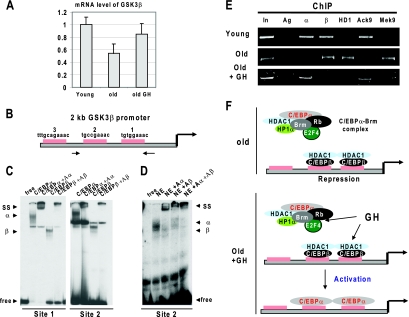FIG. 3.
GH increases expression of GSK3β in the liver by removal of epigenetic silencing the GSK3β promoter. (A) Treatment of old mice with GH increases expression of GSK3β mRNA. Quantitative reverse transcriptase PCR was performed with RNA isolated from livers of young, old, and GH-treated old mice. Levels of GSK3β mRNA were calculated as ratios to the GAPDH control. Error bars indicate standard deviations. (B) The GSK3β promoter contains three C/EBP sites. The diagram shows the locations of C/EBP sites within the mouse 2-kb GSK3β promoter. Sequences on the top are C/EBP consensus sequences. Arrows show positions of primers used for ChIP. (C) C/EBPα and C/EBPβ bind to the GSK3β promoter. EMSA was performed with nuclear extracts from HEK293 cells transfected with C/EBPα or with C/EBPβ. The left image shows EMSA with a DNA probe covering site 1; the right image shows EMSA with site 2. Antibodies to C/EBPα (Aα) and C/EBPβ (Aβ) were incorporated in the binding reaction mixtures as shown at the top. SS, supershift; α, shift with C/EBPα; β, shift with C/EBPβ. (D) C/EBPα and C/EBPβ bind to the GSK3β promoter. Nuclear extracts from mouse liver (NE) were incubated with a DNA probe covering site 2. Antibodies to C/EBPα and C/EBPβ were added in the binding reaction mixtures as shown at the top. (E) ChIP assay with chromatin solutions from young, old, and GH-treated old mice. C/EBPα (α), C/EBPβ (β), HDAC1 (HD1), AcK9 histone H3 (Ack9), and trimethyl K9 histone H3 (Mek9) were precipitated from chromatin solutions. PCR was performed with primers covering sites 1 and 2 on the GSK3β promoter (see panel B). In, 1/100 of input; Ag, precipitation with agarose beads. (F) A hypothetical model for the epigenetic silencing of the GSK3β promoter in livers of old mice and for the mechanisms by which GH activates the promoter (see text).

